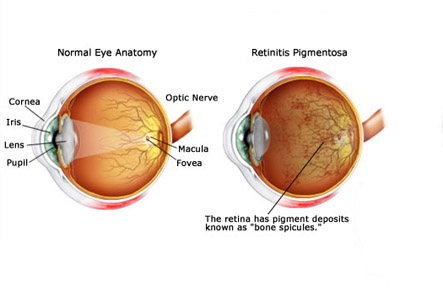Retinitis Pigmentosa
Introduction
Retinitis pigmentosa (RP) is a diverse group of inherited eye disorders. These eye conditions affect a part of the eye called the retina. RP leads to permanent changes in the vision but the rapidity and extent of changes differ from patient to patient. These changes may include difficulty with vision in dim light or in the dark and the loss of peripheral field of vision.
In retinitis pigmentosa patients, sight loss is gradual but progresses over a period of several years. Some people with RP may even become blind but most people with RP retain some useful vision till the old age.
All types of RP affect the retina. The retinal cells gradually stop working and eventually die. In most cases, the peripheral rod cells are affected first and the central cone cells are affected later. The symptoms depend on the mode of affection of retina by RP and can vary from person to person.
Iranian scientists have moved to the forefront in embryonic stem cell research, according to a recent joint study by Harvard University and the Massachusetts Institute of Technology

Stem Cell Treatments Give New Hope to Patients with Retinitis pigmentosa
Once the stem cells reach the site of the retinal vasculature, they provide a protective effect, by rescuing and stabilizing the retinal vessels. This prevents further degeneration of retinal cells.
Treatment of retinitis pigmentosa by using stem cells utilises the properties of stem cells and/or their products to protect neurons (stem cells are neuroprotective) and regenerate the damaged cells in the eye. The eyes are particularly well suited for transplant therapies because they are strategically protected from normal inflammatory immune responses. This protected status of the eyes is referred to as ‘immune privilege’. This is present only for the eye and the brain. This environment in the eye is created by a physical blood-tissue barrier which prevents the influx of inflammatory immune cells, and also by active immunological mechanisms that blunt the immune response in these sites to make it less harmful.
There are many different types of stem cells. Some of these stem cells are very useful within stem cell treatment, whereas others are less useful or potentially harmful. There are various types of stem cells present in the eye itself which are as follows:
• Limbal stem cells (which support the cornea and protect the eye from wear and tear).
• Conjunctival stem cells (which continuously bathe the eye in tears and mucous).
Treatment of retinitis pigmentosa by using stem cells utilises the properties of stem cells and/or their products to protect neurons (stem cells are neuroprotective) and regenerate the damaged cells in the eye.
These local stem cells harvested from the eye can be utilized for therapy of retinitis pigmentosa, but the factors implicated on the collection are so many (invasive, risk of contamination, damage tissue surrounding the collection, amount of cell to harvest, etc.) that makes the procedure almost impossible, ineffective and risky. Therefore collecting the stem cells from bone marrow and concentrating the specimen for a direct injection is the proper balance to keep the procedure, safe, effective and affordable. Stem cells which originate outside the eye also may be used for repairing eye damage and restoring vision loss. They include adult stem cells (bone marrow stem cells, mesenchymal stem cells, neural stem cells and embryonic stem cells). These treatments are under research for various diseases of the eye and the initial results seem to be promising.
The injected stem cells protect the retinal neurons from death. The neuronal protection seems to be specific for the cones, which are the types of photoreceptors found predominantly in the human macula (the centre of the retina responsible for fine, or reading, vision).
These cells act as firefighters which are protected from apoptosis the way like the firefighter is protected from heat and flames by specialized gear. The stem cells also extend their protection to the surrounding cells of the retina.
Once inside the degeneration site in the retina, these stem cells produce heat shock proteins and probably induce other cells to produce them as well. This prevents the retinal and vascular degeneration.
These stem cells can be genetically engineered to secrete continuously which make huge amounts of beneficial factors as mentioned above. This concept can be well adapted for treating retinitis pigmentosa.
To conclude, this new therapy can alleviate the suffering of many patients having this incurable disease.